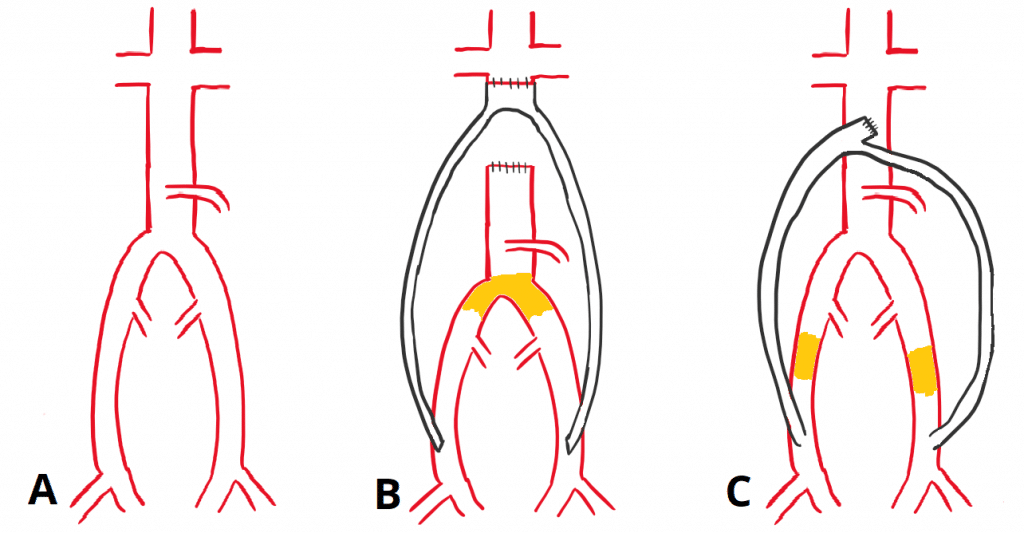This article is for educational purposes only. It should not be used as a template for consenting patients. The person obtaining consent should have clear knowledge of the procedure and the potential risks and complications. Always refer to your local or national guidelines, and the applicable and appropriate law in your jurisdiction governing patient consent.
Overview of Procedure
An aorto-bifemoral or aorto-femoral bypass involves dissection of the common femoral arteries in the groin, followed by a laparotomy, dissection to the abdominal aorta, and then clamping of the artery below the renal arteries. For the iliofemoral approach this can be achieved through a low midline incision and the clamp applied to the common iliac artery.
The aorta is then opened (Fig. 1) typically to undertake an end to side anastomosis (as this still permits some native perfusion on the lumbar and inferior mesenteric arteries) or end to end anastomosis (if there is concurrent aneurysmal disease). A tube or bifurcated graft is then sutured from the proximal arteriotomy to the femoral artery.

Figure 1 – Aortobifemoral bypass. A: Normal anatomy; B: End-to-end anastamosis; C: End-to-side anastamosis.
Complications
Intraoperative
| Complication | Description of Complication | Potential Ways to Reduce Risk |
| Haemorrhage | Particularly in the case of severe atherosclerotic disease, clamping below the renal arteries can be problematic and the blood loss can be extensive, requiring use of a cell-saver machine as an absolute minimum, often also requiring blood transfusion(s). | |
| Injury to surrounding structures including bowel, bladder and ureter | The bowel must be moved aside to access the aorta, and in patients with adhesions from previous surgery this can be challenging. The ureter lies next to the iliac arteries and can be damaged if care is not taken. | Decompress the bladder with a catheter |
| Anaesthetic risks | Includes damage to the teeth, throat and larynx, reaction to medications, nausea and vomiting, cardiovascular and respiratory complications. | Forms a part of the anaesthetist assessment before the operation |
Early
| Complication | Description of Complication | Potential Ways to Reduce Risk |
| Pain | The patient will most likely have an epidural anaesthetic to minimise pain. | |
| Bleeding | There is a small chance of bleeding and bruising in the abdomen post-operatively. | |
| Infection | Superficial wound infection is possible, yet graft infections are also possible and are major complication that require life-long antibiotics and graft excision if possible. | Peri-operative antibiotics will reduce the risk of wound and graft infections |
| Scarring | A midline or transverse incision will result in a scar, which may form a keloid scar, particular in high risk ethnicities. | |
| Seroma | A swelling of lymphatic fluid may occur in the abdomen or groin due to disruption of the lymph nodes and channels. | Careful dissection of the lymphatic nodes and channels with ligation will minimise this risk. |
| Blood clots | DVTs and PEs are a possibility in any operation. The risk is increased in patients with a raised BMI, on the pill, recent flights, previous DVT, pregnancy, smokers, cancer and prolonged bed rest. | The patient will be given anti-embolism stocking and low molecular weight heparin peri-operatively to minimise this risk as deemed appropriate. |
| Compartment syndrome | Compartment syndrome may occur in patients with prolonged clamp times or in the acute setting. Patients with a long history of peripheral vascular disease are preconditioned for ischaemia so it is less likely to occur in such patients | Minimise clamp times |
| Bowel ischaemia | The inferior mesenteric artery may be excluded during the procedure. Collateral circulation from the superior mesenteric artery and coeliac axis will usually prevent this complication, however in cases of SMA or coeliac stenosis bowel ischaemia may occur. | |
| Stroke, MI, kidney failure, death | Although small, this is always a risk in any major surgery |
Late
| Complication | Description of Complication | Potential Ways to Reduce Risk |
| Hernia | Any laparotomy incision has the potential to cause a hernia in future. | Avoid heavy life for 6 weeks post-surgery. |
| Adhesions | Abdominal surgery may cause adhesions as a reaction to the procedure. | |
| Graft occlusion | A kink or narrowing in the graft can lead to occlusion and acute limb ischaemia, requiring thrombolysis, embolectomy, or placement of a new graft, however this is uncommon in these types of bypass surgery. | |
| Impotence | An alteration in the blood supply to the pelvis can cause impotence, as well as damage to the nerves which pass across the aortic bifurcation and are often cut | |
| Reintervention | The reintervention rate for aortic or iliac femoral bypass grafts is small compared to more distal grafts, but may occur due to any of the reasons outlined above. |
